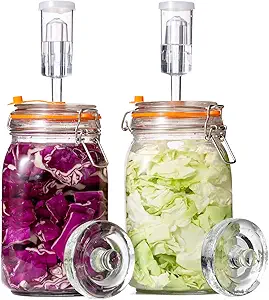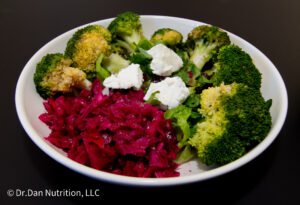
Fermented Vegetables, A.K.A. sauerkraut, kimchi
Please don’t leave! You might think you don’t like fermented vegetables, like sauerkraut or kimchi, but wait! The mass-produced restaurant and store brands are nothing like the homemade version I can show you. I never thought I liked fermented vegetables either, but then I saw a YouTube video on how to make sauerkraut and realized how easy it is. Once I tried it, I couldn’t believe how flavorful and fun these foods are to eat. In addition, they have incredible health benefits. Fermentation eliminates most inflammatory lectins while adding K2 and other vitamins, as well as enhanced flavors. Please give fermented vegetables a try before passing them off as unworthy.
Basic sauerkraut.
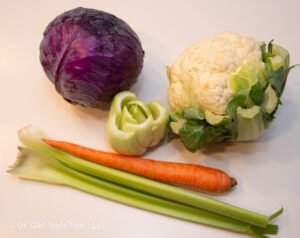
Any combination works, and the photo shows a more exotic combination: purple cabbage, carrots, bok choy, celery, and cauliflower. For your first batch, I recommend using green cabbage. The amount you need depends on the size of your container. A one-liter fermentation jar uses about one kilogram of chopped cabbage. I know, I know—the metric system. Sorry, folks, but for these recipes, you really want to use the metric system. It will make more sense later. A 1.5-liter jar uses 1.5 kg of cabbage (or total vegetables). See how easy it is? In ounces, a 34-oz. jar uses 2 lb. 3 oz. of chopped vegetables. Stick with the metric system here.
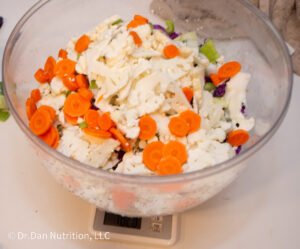
Next is the salt, which should be about 2% by weight. This does not have to be exact. In metric, this is also very easy. For every 1000 grams (1 kg) of chopped vegetables, you need 20 grams of salt. Weigh your vegetables and multiply by 0.02 to find the amount of salt needed. It does not need to be exact, and up to 3% is fine. I like to use iodized Aegean Sea salt. Don’t use salt with a high potassium or magnesium content, as this will allow the wrong bacteria to grow. I found this out the hard way.
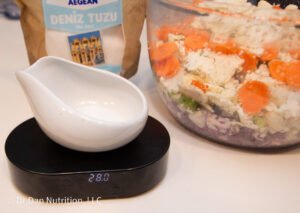
Now, get your grip workout in by mixing and crushing the vegetables by hand with the salt. If you want to add a tablespoon of dill or other herbs, do so now. Keep squeezing and mixing the vegetables and salt until they start to wilt and become wet.
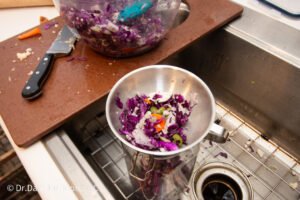
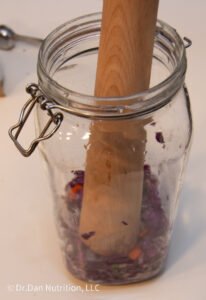
Scoop all of the ingredients, including the liquid, into a fermentation jar. Using a wide-mouth funnel or kitchen tongs. A wooden “sauerkraut pounder” is nice for packing it down tight. Leave at least two inches of space at the top of the jar. Cut a large cabbage leaf into a circle and place it on top of the chopped cabbage to keep the small pieces from floating up. Then, add the weight that comes with the fermentation kit, if you bought one. If the top is dry, make a small amount of brine to top it off. Do not use plain water. Using a coffee scale, add 2 grams of salt for every 100 grams of water and Mix well, then use this mixture to ensure all the vegetables are submerged in liquid.
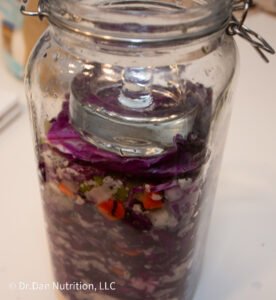
Label the jar with the date and any special treatments, such as herbs. Then, place the airlock on top. Fill the airlock with regular water. Only fill it halfway. That’s it! Leave it alone for 7–14 days. You will see bubbles starting on day one, and the colors will change dramatically if you use colored vegetables such as radicchio or red cabbage. Note that radicchio requires three weeks of fermentation to reduce the bitterness. Some of my favorite combinations are listed below. Feel free to take a taste anytime to check on the progress and see if it has reached your preferred level.
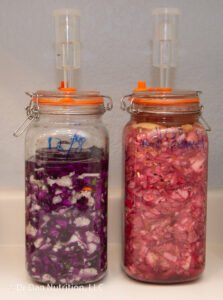
When you’re ready to eat, remove the airlock, close the hole, and put it in the refrigerator overnight. The next day, empty the contents into a container and let it gas off for a couple of hours. Sulfur-producing bacteria create some of the amazing compounds. The finished sauerkraut will last for weeks in the refrigerator, but it will likely be eaten long before then. Check out the equipment page to find the jars, funnels, and pounders to make your own amazing fermented vegetables!
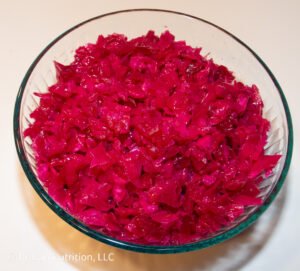
Some favorite combinations:
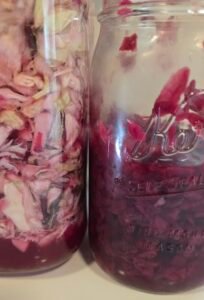
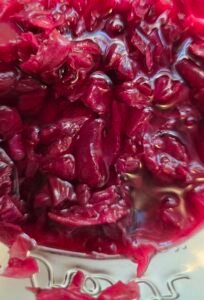
Two heads of radicchio and bok choy stems (the leaves are great for salads) fermented for two to three weeks create an amazing wine-like flavor with a slightly bitter, crunchy bite.
Taste of Thai:
Green Cabbage: 1 large head
Green Onions: 1 or 2 bunches, including the whites and roots
Fresh Ginger: 3 or 4 thin slices
Go easy on the ginger, as it becomes very powerful when fermented. This fermented food is crunchy, tangy, and zippy.

